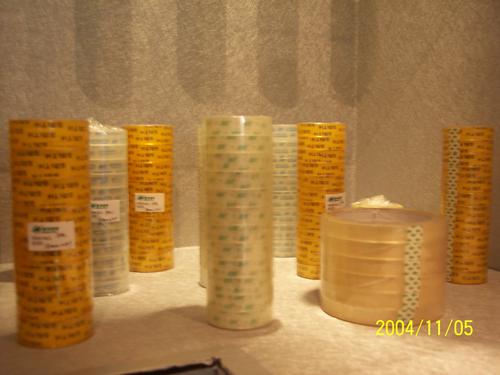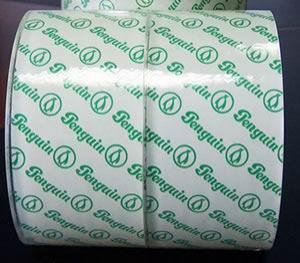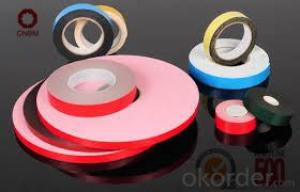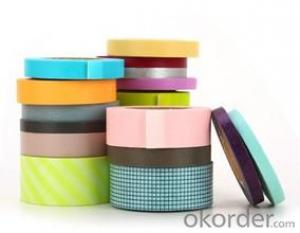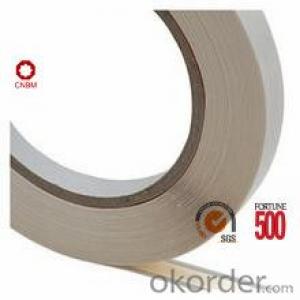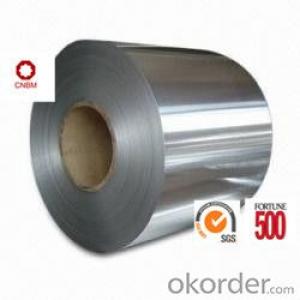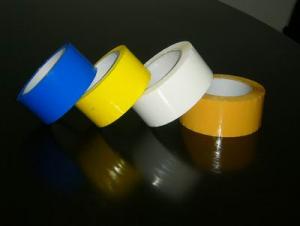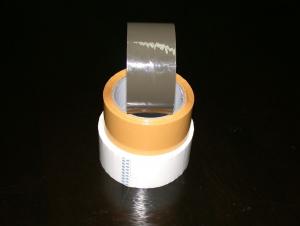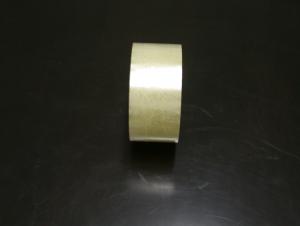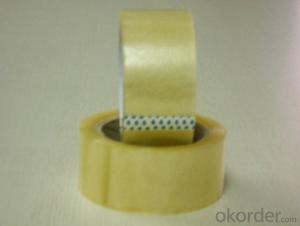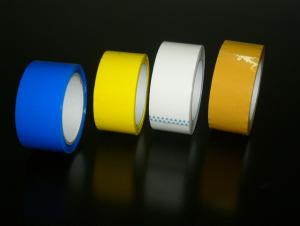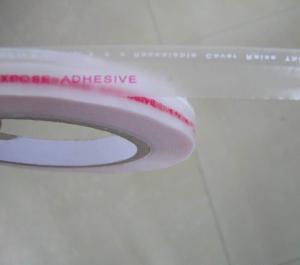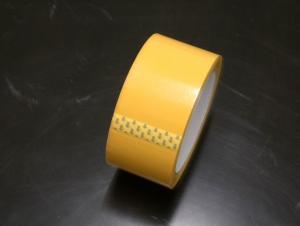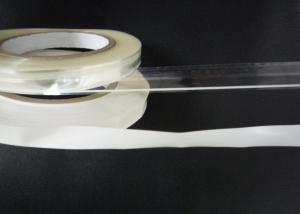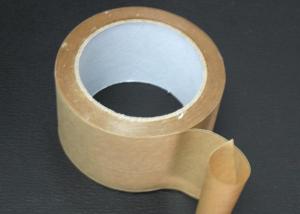White Paper Packaging Tape - Logo Print BOPP Adhesive Tapes BP-1
- Loading Port:
- China Main Port
- Payment Terms:
- TT OR LC
- Min Order Qty:
- -
- Supply Capability:
- -
OKorder Service Pledge
OKorder Financial Service
You Might Also Like
Product Description:
Quick details:
· Material: BOPP
· Use: Carton Sealing
· Adhesive Side: Single Sided
· Adhesive: Acrylic
· Adhesive Type: Water Activated
· Design Printing: Offer Printing
· Place of Origin: China (Mainland)
· color: clear, super clear, crystal clear, red, blue, brown, yellow, green etc
Specifications:
ItemNo. | Carrier | Adhesive | Total | Initial | Peel Adhesion | Holding | Tensile | Elongation |
BP-40 | BOPP film | water based acrylic | 40 micron | >18# | 0.5kgf/25mm | >24h | >30N/cm | <180% |
BP-45 | BOPP film | water based acrylic | 45 micron | >18# | 0.5kgf/25mm | >24h | >30N/cm | <180% |
BP-50 | BOPP film | water based acrylic | 50 micron | >20# | 0.5kgf/25mm | >24h | >30N/cm | <180% |
BP-65 | BOPP film | water based acrylic | 65 micron | >24# | 7.88N/25mm | >40h | >30N/cm | <180% |
Application:
Bopp tape is mainly for Carton sealing & packing, Light duty packaging, bundling, holding, and other office & household use.
Packing:
Paper Core ID: 76mm
Jumbo size: 1280mm x 4000m; 1625mm x 4000m
Cut roll size: As per customer's requirement
Cut rolls: 6 rolls per shrink, 36/54/72 rolls per carton with or without pallet
Jumbo rolls & log rolls: Packed with kraft paper and stretch wrap film, with or without pallet
- Q: Can packaging tape be used for sealing arts and crafts materials?
- Yes, packaging tape can definitely be used for sealing arts and crafts materials. It is a versatile adhesive that can easily attach and secure various types of materials, including paper, cardboard, fabric, and more. Whether you are sealing envelopes, wrapping gifts, or creating art projects, packaging tape can provide a strong and long-lasting bond, ensuring that your arts and crafts materials stay securely sealed. Additionally, packaging tape is usually clear, which allows it to blend seamlessly with your project, making it an excellent choice for sealing arts and crafts materials.
- Q: How do I prevent packaging tape from tearing during removal?
- To prevent packaging tape from tearing during removal, you can try gently heating the tape with a hairdryer to soften the adhesive. This will make it easier to peel off without tearing. Additionally, you can use a knife or a razor blade to carefully cut along the edges of the tape before peeling it off.
- Q: Can packaging tape be used for mailing packages?
- Absolutely, packaging tape is perfect for mailing packages. Its main purpose is to securely seal packages and guarantee their integrity while in transit. This type of tape is known for its strength and durability, which makes it the ideal choice for securing boxes, envelopes, or any other packaging material. It is widely utilized in shipping and mailing scenarios and comes in different sizes and strengths to adapt to various package dimensions and weights. Regardless of whether you are sending a tiny envelope or a substantial box, packaging tape is an indispensable tool to guarantee the proper sealing and protection of your package throughout the mailing process.
- Q: Is packaging tape resistant to extreme temperatures or weather conditions?
- Packaging tape is typically constructed to endure extreme temperatures and diverse weather conditions, although the degree of resistance may fluctuate depending on the tape's specific type and quality. Most packaging tapes are composed of robust materials like polypropylene or PVC, renowned for their durability and ability to withstand environmental elements. These tapes are often treated with specialized adhesives that retain their stickiness even in harsh temperatures or humid surroundings. Concerning extreme temperatures, packaging tapes are generally engineered to withstand a broad spectrum, including both frigid and scorching extremes. They can typically endure temperatures as low as -20 degrees Celsius or as high as 60 degrees Celsius without compromising their adhesive properties or becoming brittle. Similarly, packaging tapes are designed to exhibit resistance against diverse weather conditions. They are formulated to repel moisture, humidity, and UV radiation, which are prevalent factors that can deteriorate tape quality. This resistance ensures that the tape remains intact and efficient, even when exposed to rain, snow, or direct sunlight. It is crucial to note that although packaging tape is generally resistant to extreme temperatures and weather conditions, prolonged exposure to such circumstances can still impact its durability. Therefore, it is advisable to store and utilize packaging tape in a controlled environment whenever feasible to guarantee maximum effectiveness.
- Q: Is packaging tape resistant to oil or grease?
- Yes, packaging tape is generally resistant to oil or grease. Packaging tapes are designed to securely seal boxes and packages, ensuring that the contents inside are protected during transportation. These tapes are typically made of materials such as polypropylene or PVC, which have properties that make them resistant to various substances including oil and grease. This resistance helps to prevent the tape from deteriorating or losing its adhesion when it comes into contact with oils or greases commonly found in industrial or commercial settings. However, it is important to note that the level of resistance may vary depending on the specific type and quality of packaging tape used.
- Q: The production of transparent tape material is what to do
- BOPP film can be produced by tube or flat film method. The BOPP films obtained by different processing methods have different properties. The BOPP film produced by the flat film method has a higher strength ratio (up to 8-10), so the strength is higher than that of the tube film, and the uniformity of the film thickness is better.
- Q: How do I seal a package securely with packaging tape?
- To seal a package securely with packaging tape, follow these steps: 1. Start by ensuring that the items inside the package are properly arranged and secured. 2. Cut a piece of packaging tape slightly longer than the width of the box. 3. Place the tape across the center of the box, ensuring it covers the flaps and overlaps on both sides. 4. Firmly press down on the tape to ensure it adheres properly to the surface. 5. Repeat this process with additional strips of tape, placing them parallel to the first strip and overlapping them slightly. 6. For added security, place strips of tape diagonally across the top and bottom flaps, creating an "X" pattern. 7. Apply pressure to the entire length of each strip to ensure a strong bond with the surface. 8. Finally, test the seal by gently tugging at the tape to ensure it holds firmly. By following these steps, you can seal your package securely with packaging tape, minimizing the risk of damage during transit.
- Q: Is packaging tape safe to use on plastic cutting mats?
- Before using packaging tape on plastic cutting mats, it is important to take a few factors into consideration. Firstly, make sure that the cutting mat is made of a durable and food-safe material. Some lower quality mats may get scratched or torn when tape is applied, so it is advisable to check the manufacturer's recommendations. Secondly, think about why you want to use packaging tape on the cutting mat. If it is for temporary storage or transportation, packaging tape can provide a secure seal. However, if the tape will come into direct contact with food or be used during food preparation, it is best to avoid using packaging tape. The adhesive residue from the tape could transfer onto the food or contaminate the cutting surface, which could be a health risk. In such cases, it is better to use food-grade or specialized tape that is specifically designed for cutting mats or food preparation surfaces. In conclusion, although packaging tape can be safe to use on plastic cutting mats, it is crucial to consider the quality of the mat, the purpose of using the tape, and potential food safety concerns. Always prioritize the safety and hygiene of your food preparation surfaces by choosing the appropriate tape.
- Q: How do I choose the right packaging tape for my needs?
- To guarantee your packages are securely sealed during transit, it is crucial to make a careful decision when selecting the appropriate packaging tape. Here are some factors to take into account: 1. Strength and durability: Take into consideration the weight and nature of your packages. For heavy or bulky items, it is advisable to choose a tape with high tensile strength that can withstand rough handling. Look for tapes made from materials like fiberglass or reinforced with polyester fibers. 2. Adhesive type: Various packaging tapes use different types of adhesives. Acrylic adhesive is commonly used and provides a good balance of performance and affordability. For challenging surfaces or extreme conditions, consider using hot melt adhesive, which offers superior bonding strength. Furthermore, water-activated tape, also known as gummed paper tape, forms a permanent bond when moistened, providing enhanced security. 3. Width and length: Determine the appropriate width and length of tape based on the size of your packages. Thicker tapes are generally more durable, and longer rolls may be more cost-effective for high-volume packaging. 4. Transparency and aesthetics: If you desire a professional appearance for your packages or need to easily see the contents, opt for clear or transparent packaging tape. However, if appearance is not a concern, colored tape can aid in easy identification or branding purposes. 5. Environmental considerations: If you are environmentally conscious, look for packaging tapes made from eco-friendly materials or those that are recyclable. Some tapes are water-based, solvent-free, or made from renewable resources, making them a greener choice. 6. Dispenser compatibility: Take into account the type of tape dispenser you have or plan to use. Ensure that the tape you choose is compatible with your dispenser, as certain tapes necessitate specific types of dispensers. 7. Cost: Finally, compare prices and consider your budget. However, bear in mind that sacrificing quality for a lower price may result in inadequate tape performance and potential damage to your packages. By considering these factors, you can make an informed decision and select the appropriate packaging tape that best suits your needs, ensuring your packages arrive securely and intact.
- Q: Can packaging tape be used for sealing construction or building materials?
- Yes, packaging tape can be used for sealing construction or building materials. While it may not be as durable or strong as specialized construction tapes, packaging tape can still provide a temporary or quick solution for sealing materials such as cardboard, plastic sheets, or lightweight panels. It can be used to secure temporary covers, attach protective layers, or hold materials in place during construction or renovation projects. However, for long-term or heavy-duty applications, it is recommended to use tapes specifically designed for construction purposes, as they are more resistant to weather, UV rays, and have stronger adhesive properties.
Send your message to us
White Paper Packaging Tape - Logo Print BOPP Adhesive Tapes BP-1
- Loading Port:
- China Main Port
- Payment Terms:
- TT OR LC
- Min Order Qty:
- -
- Supply Capability:
- -
OKorder Service Pledge
OKorder Financial Service
Similar products
Hot products
Hot Searches
Related keywords


